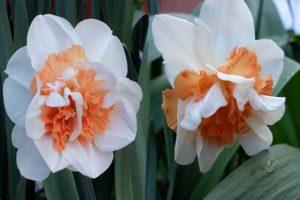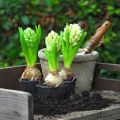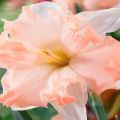Description and characteristics of Rosie Cloud daffodils, cultivation technology and care
Rosie Cloud narcissus was created especially for romantic natures who prefer beautiful and unusual plants. The translation means "Pink Clouds", which fully characterize the exotic beauty of terry daffodils, which exude tenderness. When choosing this variety for decorating a backyard, you should carefully study its advantages and disadvantages, the main agrotechnical requirements for planting and care.
Description and characteristics of Narcissus Rosie Cloud
Narcissus Rosie Cloud is an early flowering perennial bulbous plant. Its height does not exceed 35-40 cm. The culture has a large double flower of a pleasant pale pink color and exudes a delightful aroma. Peduncles are strong and persistent. Densely placed basal leaves of a dark green hue. The flower, whose diameter varies from 5 to 7 cm, pleases with flowering from April to May for 8-10 days. In cool weather, it may not bloom, since the culture is thermophilic, it needs a lot of moisture and heat.
The daffodil variety Rosie Cloud is widely used in landscape design, bouquets that will stand for 5 days.

Advantages and disadvantages
Daffodils of the Rosie Cloud variety are very popular among gardeners due to their attractive appearance and a number of positive qualities:
- early flowering period;
- undemanding to soil and climatic conditions;
- disease and pest resistance;
- frost resistance, the ability to withstand temperatures as low as -25 degrees;
- the possibility of using for landscaping and for pruning.
The disadvantages of the variety include the complexity of the germination process, since the bulb will not grow in unmoistened poor soil or at low air temperatures.
How to grow a variety correctly
Before buying a daffodil Rosie Cloud, it is recommended to carefully study the rules and nuances of planting.

Boarding time
The best time to plant daffodil bulbs is August or the first decade of September. If you do not adhere to the optimal planting dates, the bulbs will not have time to take root before the onset of cold weather and will die.
Preparation of seedlings
Rinse high-quality planting material under running water.To disinfect the bulbs, place them in a potassium permanganate solution for 15-20 minutes. Dry at 25 degrees in a well-ventilated place.

Site selection
Pay special attention to the choice of the place where the daffodil Rosie Cloud will grow. The culture is undemanding to lighting and perfectly tolerates both partial shade and direct sunlight. If the site is with poor soil, then enrich it with a complex of mineral and organic substances. You also need to exclude light sandy soils, since they do not retain heat when winter comes.
Advice! The ideal solution would be to give preference to areas with drained loamy soil.
Planting process
The landing algorithm consists of the following steps:
- Free the area from weeds. Dig up and loosen the soil thoroughly.
- Dig holes 15-20 cm deep, keeping the distance between them 10-12 cm.
- Put a thin layer of sand at the bottom of each recess; it will act as a drain.
- Carefully lower the bulb into the hole so that the root shoots are directed downward.
- Moisten the planting site a little and cover it with earth and sand.
At this stage, the planting process is considered complete, further plant care should be carried out in a timely manner, taking into account all the nuances.

Crop care recommendations
Important criteria for growing, on which the decorativeness of the plant, its lush flowering directly depend, is considered to be competently performed care, consisting of such standard measures as watering, feeding, pruning, combating diseases and pests, preparing for winter.
Watering rules
It is necessary to moisten the soil around the plant as it dries. If rainy weather persists for a long time, the culture should be covered with foil to avoid rotting of the bulbs.
After watering, loosen the soil so that air flows to the bulb.

Top dressing
Feed the plant regularly and in a timely manner. Perform the first fertilization as soon as the first shoots appear. The next feeding is done from the beginning of the formation of the first buds. Further procedures are required during the flowering period and after the buds are completely dry.
Pruning
Before preparing the plant for winter, you need to cut off all the buds. The peduncle can be cut off as soon as the flower withers.
Preparing for the winter period
It is necessary to cover daffodils for the winter, especially if they grow in areas where severe frosts are observed. After the onset of cold weather, loosen the soil on the site and mulch with sawdust, straw, dry leaves, peat or wood ash. The thickness of the mulch layer should be 10-15 cm.
It is recommended to cover the area with spunbond or lutrasil.

Fight against disease and flower pests
Daffodils are affected by diseases in case of improper planting or poor-quality agrotechnical measures. The cause of the development of a fungal infection can be:
- high or low humidity during storage of bulbs;
- neglect of preliminary antiseptic treatment of planting material;
- a large amount of nitrogen in the soil.
The most common diseases are fusarium, gray and brown rot, spotting, stem nematode, and white streak. Daffodils and such harmful insects as an onion hoverfly, a daffodil fly, and a root onion mite have chosen.
The main methods of fighting diseases are fungicides, and pests are insecticides.
Breeding flowers
Daffodil variety Rosie Cloud reproduces only vegetatively.

Use of Rosie Cloud in landscaping
The variety is used for landscaping home gardens, flower beds. Looks great in compositions with early flowering plants, between shrubs, separate planting is also popular.
Advice! It is better to plant plants in a flower bed with late flowering crops, since the leaves of daffodils retain their decorative effect until the onset of cold weather.









